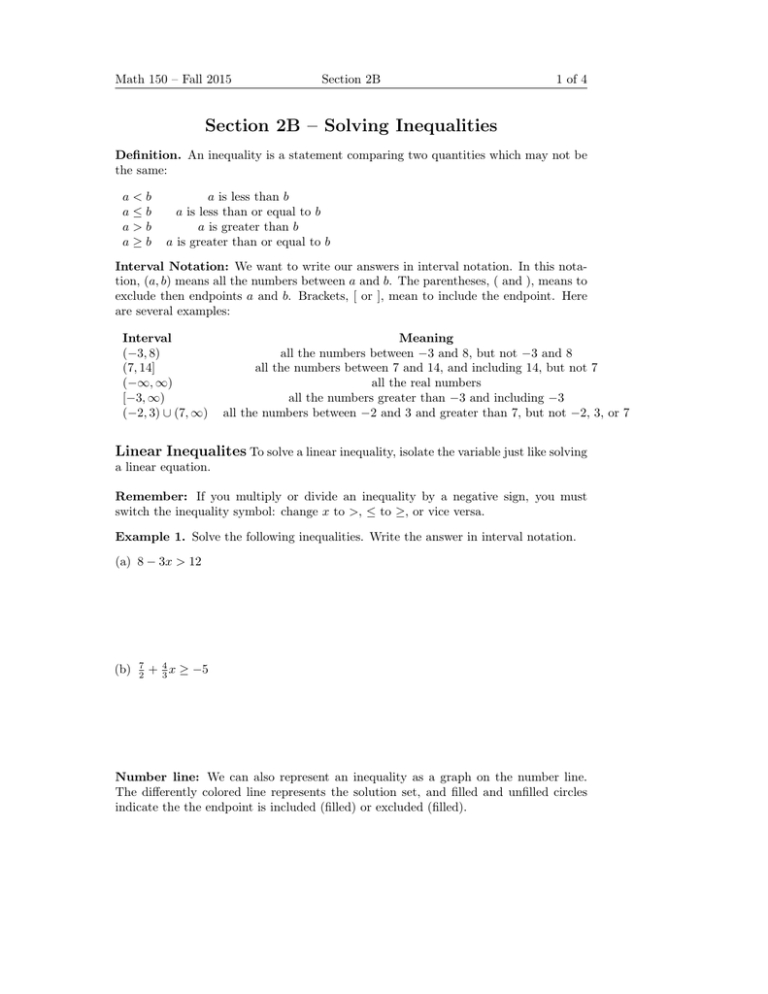Section 2B – Solving Inequalities
advertisement

Math 150 – Fall 2015 Section 2B 1 of 4 Section 2B – Solving Inequalities Definition. An inequality is a statement comparing two quantities which may not be the same: a<b a≤b a>b a≥b a is less than b a is less than or equal to b a is greater than b a is greater than or equal to b Interval Notation: We want to write our answers in interval notation. In this notation, (a, b) means all the numbers between a and b. The parentheses, ( and ), means to exclude then endpoints a and b. Brackets, [ or ], mean to include the endpoint. Here are several examples: Interval (−3, 8) (7, 14] (−∞, ∞) [−3, ∞) (−2, 3) ∪ (7, ∞) Meaning all the numbers between −3 and 8, but not −3 and 8 all the numbers between 7 and 14, and including 14, but not 7 all the real numbers all the numbers greater than −3 and including −3 all the numbers between −2 and 3 and greater than 7, but not −2, 3, or 7 Linear Inequalites To solve a linear inequality, isolate the variable just like solving a linear equation. Remember: If you multiply or divide an inequality by a negative sign, you must switch the inequality symbol: change x to >, ≤ to ≥, or vice versa. Example 1. Solve the following inequalities. Write the answer in interval notation. (a) 8 − 3x > 12 (b) 7 2 + 43 x ≥ −5 Number line: We can also represent an inequality as a graph on the number line. The differently colored line represents the solution set, and filled and unfilled circles indicate the the endpoint is included (filled) or excluded (filled). Math 150 – Fall 2015 Section 2B 2 of 4 Definition. The statement a < x < b means that x is between a and b, but not including a or b, i.e., a < x and x < b To solve these combined inequalities, just split them into the two simpler inequalities and solve. Example 2. Solve the following inequalities. Write the answer in interval notation. Also, graph the solution on the number line. (a) −7 ≤ 5 − 4x < 12 (b) 5x − 3 < 6x − 8 < 4x − 5 (c) 5 − 2x < 3x + 1 < 5x − 2 Absolute Value Inequalities: Inequalities with an absolute value can be thought of as a distance. Example 3. Draw a graph on the number line for the following two inequalities. (a) |x| < 4 (b) |x| > 4 Solving Absolute Value Inequalities: We need to break the absolute value into two different inequalities. These are the different cases: |x| < a is equivalent to −a < x < a. |x| ≤ a is equivalent to −a ≤ x ≤ a. and |x| > a is equivalent to x > a OR x < −a |x| ≥ a is equivalent to x ≥ a OR x ≤ −a Math 150 – Fall 2015 Section 2B 3 of 4 Example 4. Solve the following inequalities and write your answer in interval notation. (a) |2x − 3| < 5 (b) |4x − 5| + 5 < 3 (c) |4x + 7| − 6 ≤ 9 (d) |x − 5| > 8 (e) |5x − 4| − 5 ≥ 13 Nonlinear Inequalities Solution Method: 1. Move every term of the inequality to one side. 2. Find the critical values, which are the values for which the expression is equal to zero or undefined. 3. Use the critical values to divide the real number line into intervals 4. Each interval is either entirely in the solution set or entirely out of the solution set. Either test a single number (not an endpoint!) or use a sign chart to determine whether each interval is a solution or not. 5. Determine whether any of the critical values (endpoints of the intervals) are in the solution set. Math 150 – Fall 2015 Section 2B Example 5. Solve the inequalities and write the answers in interval notations. (a) x2 + 4x − 5 ≤ 0 (b) x4 − 2x3 > 8x2 (c) 2x−7 x−5 (d) 4x2 −16 x2 −5x ≤3 ≥3 4 of 4




